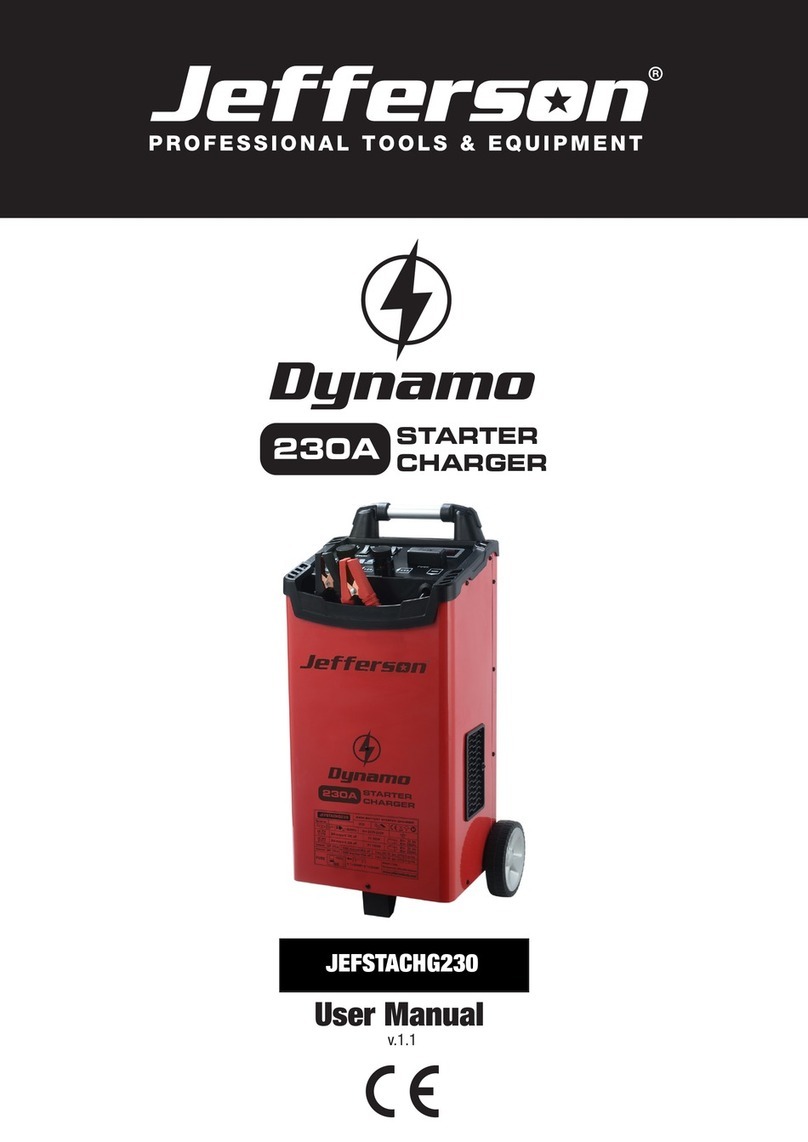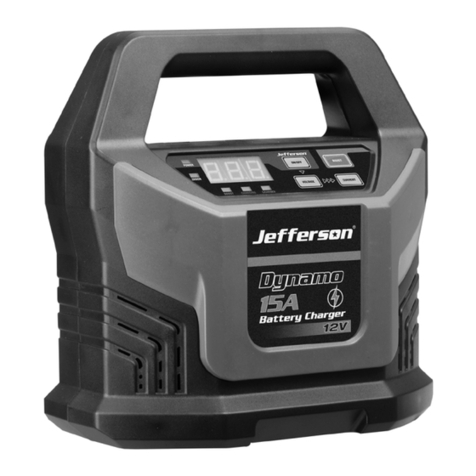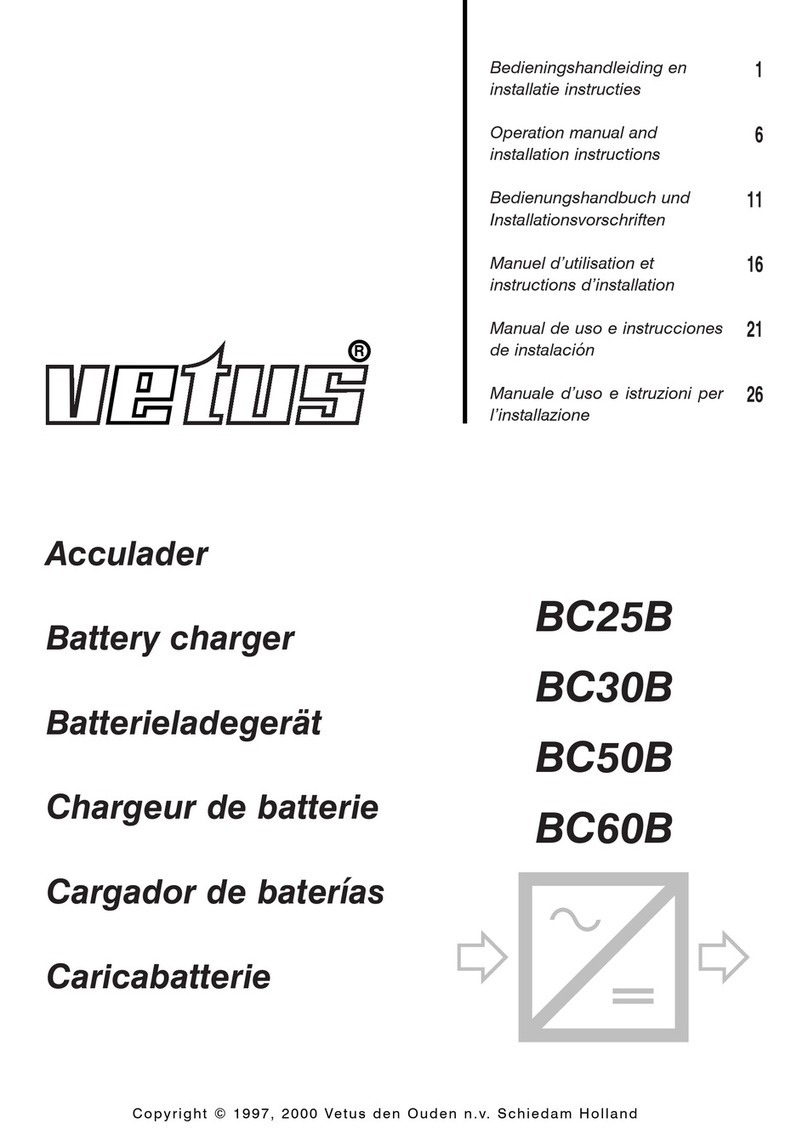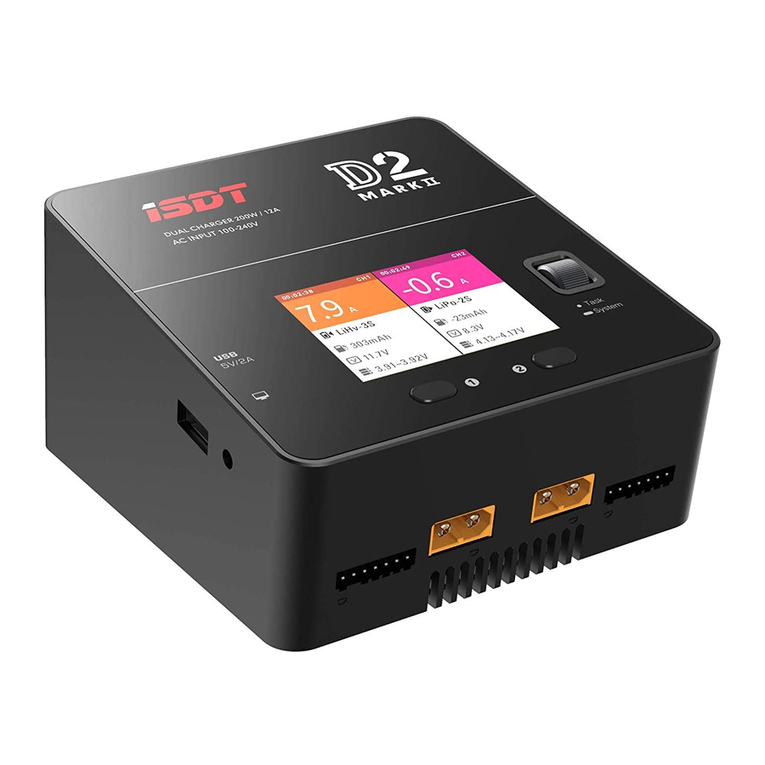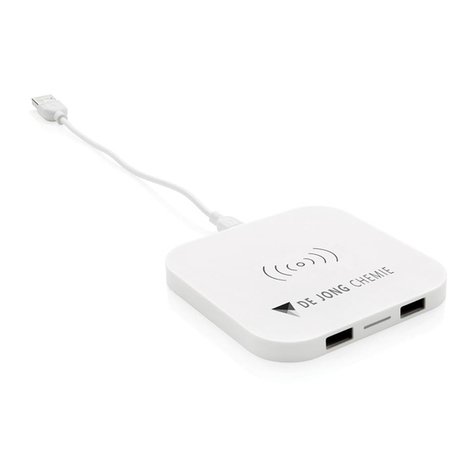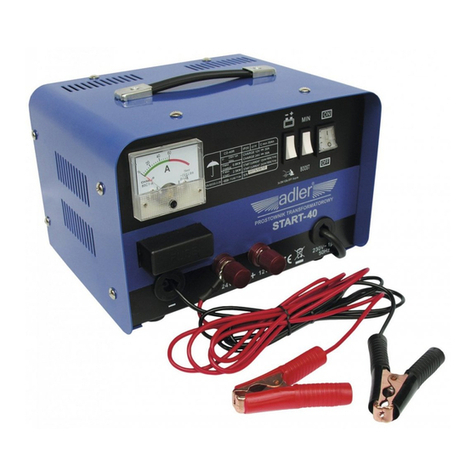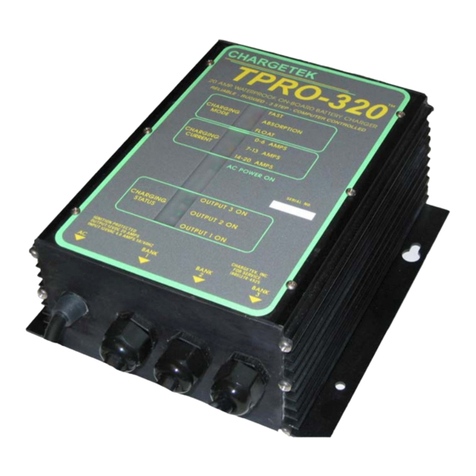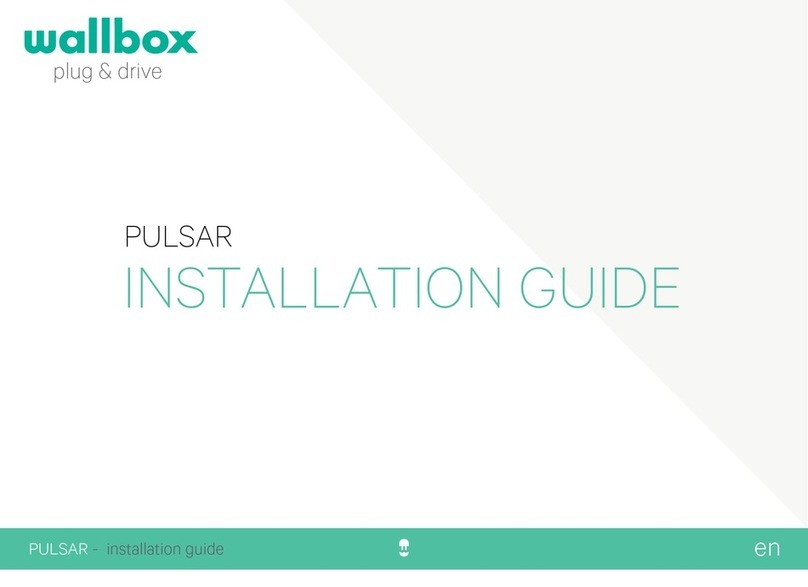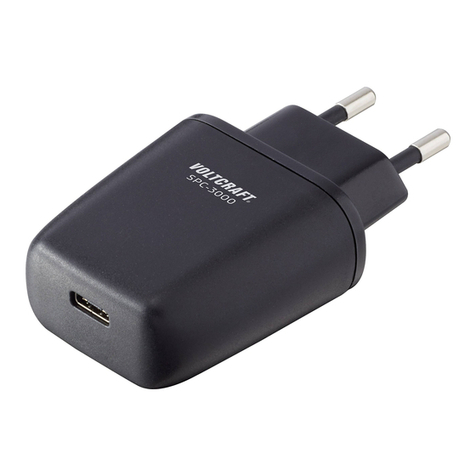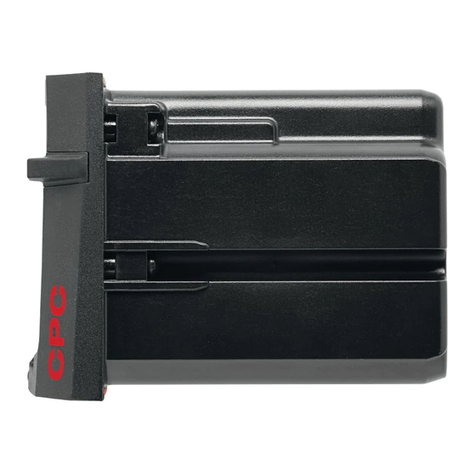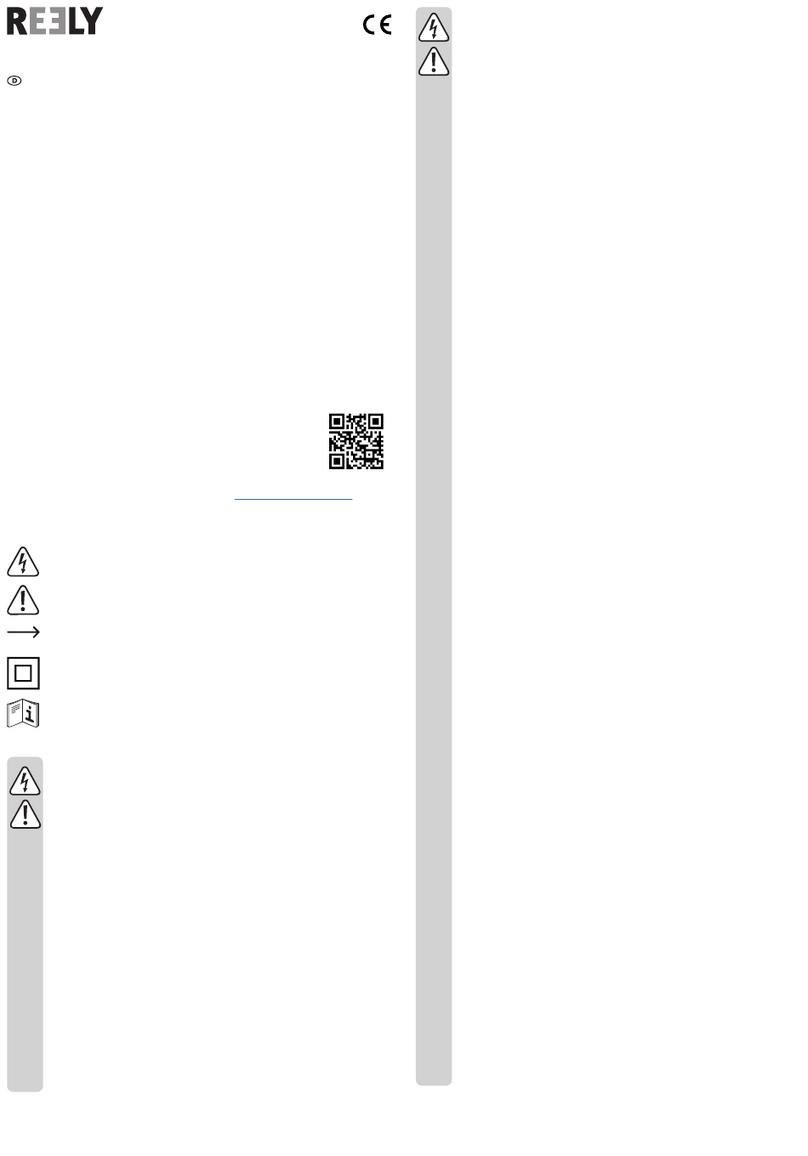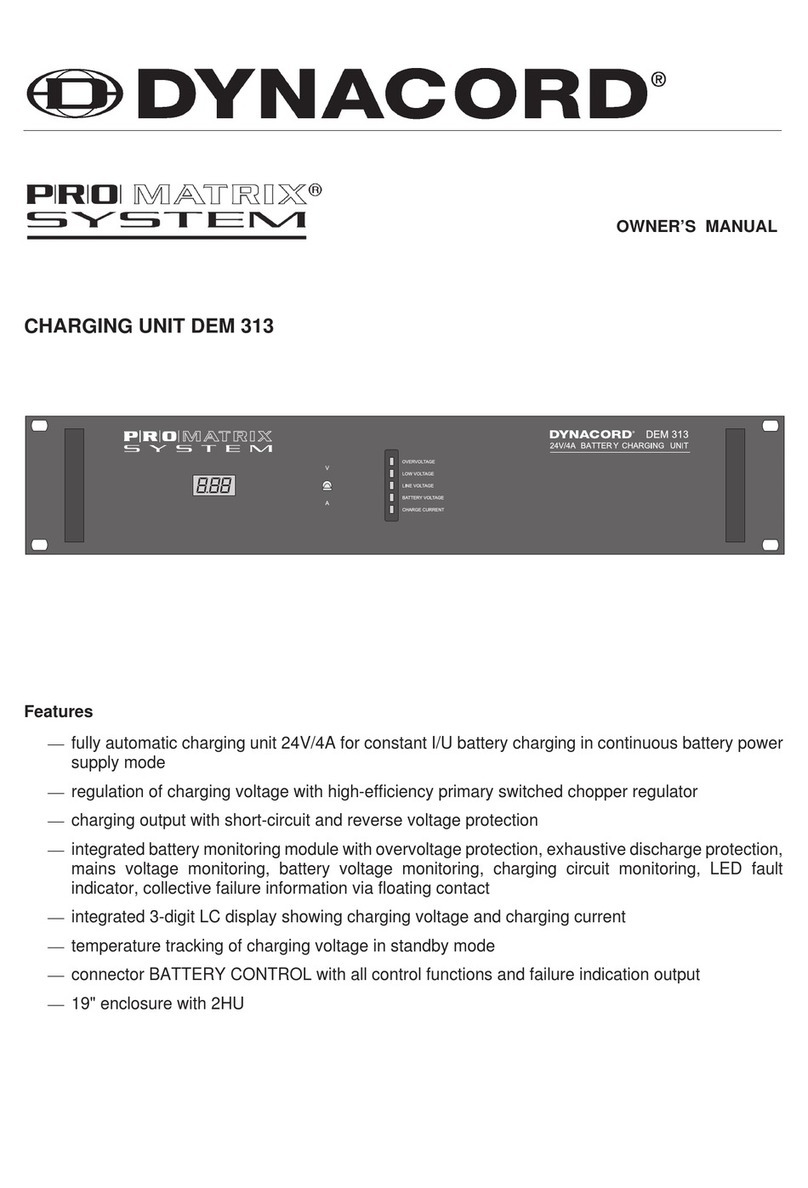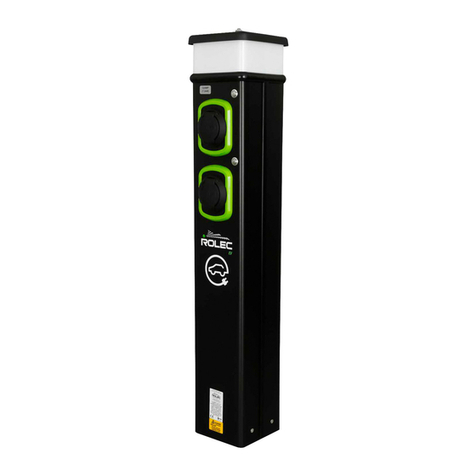Jefferson Dynamo 430A STARTER CHARGER User manual

User Manual
v.1.1
JEFSTACHG430
Dynamo
STARTER
CHARGER

USER MANUAL v1.1
JEFSTACHG430
430A STARTER CHARGER •230V ~50Hz
www.jeffersontools.com
2

USER MANUAL v1.1
JEFSTACHG430
430A STARTER CHARGER •230V ~50Hz
www.jeffersontools.com 3
Introduction 4
Specications 4
Unpacking & Assembly 4
Equipment Identication 4
Safety Warnings 5
Equipment Safety Guidelines 6
Electrical Safety 7
Electrical Wiring Diagram 7
Operation Guide 8
Maintenance 10
Troubleshooting 10
Environmental Protection 11
WEEE Waste Electrical and Electronic Equipment Statement 11
Parts List & Diagram 12
EC Declaration of Conformity 13
Limited Warranty Statement 14
Important: Please read all these instructions before operating this product and save these instructions. This manual has been compiled by
Jefferson Tools and is an integrated part of the product with which it's enclosed and should be kept with it for the future reference.
This manual describes the purpose for which the product has been designed and contains all the necessary information to ensure its correct and
safe use. We recommend that this manual is read before any operation or, before performing any kind of adjustment to the product and prior to
any maintenance tasks. By following all the general safety instructions contained in this manual you will help to ensure operator safety and extend
the potential life span of the equipment.
All photographs and drawings in this manual are supplied by Jefferson Tools to help illustrate the operation of the product. Whilst every effort
has been made to ensure accuracy of information contained in this manual our policy of continuous improvement determines the right to make
modifications without prior warning.
NOTE: The information contained in this Instruction Manual is designed to assist you in the safe operation and maintenance of this equipment.
Some illustrations in this Instruction Manual may show details or attachments that differ from those on your own equipment. Contact your
nearest Jefferson Dealer if you are unsure about any information included in this manual or require any additional information about the safe use,
operation maintenance, or repair of this equipment.
CONTENTS

USER MANUAL v1.1
JEFSTACHG430
430A STARTER CHARGER •230V ~50Hz
www.jeffersontools.com
4
• 430A single phase battery / starter charger with sturdy plastic and steel housing and carry handle
• 12/24V battery voltage
• Well ventilated to help maintain low temperatures during operation
• Large ammeter display showing rate of charge
• Dash-mounted fuse and polarity protection
• Variable charging rate
• Supplied with a pair of fully insulated positive and negative charging clamps which can be stored within the equipment casing
• Suitable for charging regular and low maintenance batteries between 60 - 800Ah
SPECIFICATIONS
TECHNICAL DATA
Model Number: JEFSTACHG430 Duty Cycle: @ 5 Cycles 5 sec ON / 30 sec OFF
Input Voltage: 230V ~ 50Hz Battery Capacity: 60 - 800Ah
Input Power: 130W Fuse: 2 x 50A
Output Voltage: 12V / 24V Ingress Protection Rating: IP21
Output Charge Peak(EN): 75A (30A) Safety class (DIN 40530): II
Output Start Peak(EN): 400A (300A) Power Cable / Plug: 3x 1.5mm x 2.4M / 13A
Input (Charge): 0.4A Charge Cables: 14mm x 2.0M
Input (Start): 3A Weight / Dimensions: 15kg / 300 x 230 x 630mm
EQUIPMENT IDENTIFICATION
INTRODUCTION
Steel Housing (IP21)
Control Panel Housing
Charging Clamps
Red = Positive (+)
Black = Negative (-)
Specication Plate
Foot
Wheels
Ventilation Grilles
Overcurrent Protection Fuse
Handle
24V Terminal
12V Terminal
Rotary Dial:
Power /
Charge & Start
Mode /
Charge
Rate
24V Terminal 12V Terminal
Fuse: (2 x 50A)
Digital Ammeter
Control Panel
Timer

USER MANUAL v1.1
JEFSTACHG430
430A STARTER CHARGER •230V ~50Hz
www.jeffersontools.com 5
Please read and ensure that you understand all of the operating instructions, safety precautions and warnings
in this user manual before operating or maintaining this equipment. An accident can often be avoided by
recognizing a potentially hazardous situation before it occurs, and by observing appropriate safety procedures.
Hazards that must be avoided to prevent bodily injury or machine damage are identied by warnings on
the equipment and in this user guide Never use this equipment or modify it in any way that has not been
specically recommended by the manufacturer. Contact Jefferson Tools for all information relating to the repair
and maintenance of this equipment. Contact a qualied electrician for advice on any issues relating to electrical
safety in your working environment. Keep a copy of this user guide with the equipment for future reference.
Wear suitable eye protection during operation.
Wear safety gloves during operation.
Wear safety gloves during operation.
Electrical hazard. Follow electrical safety guidelines before use.
Potentially explosive materials and gases. Read equipment operating guidelines and safety information
for the battery before charging.
Risk of explosive gases. Do not use near explosive or flammable materials. Keep away from sources of
ignition.
Only use in well-ventilated environments.
Keep equipment dry at all times. Do not operate in wet conditions. Store in a dry environment.
Equipment should not be disposed of with household waste. Follow WEEE guidelines for disposal.
SAFETY WARNINGS

USER MANUAL v1.1
JEFSTACHG430
430A STARTER CHARGER •230V ~50Hz
www.jeffersontools.com
6
EQUIPMENT SAFETY GUIDELINES
Read and ensure that you understand all of the operating instructions, safety precautions and warnings in this instruction
manual before operating or maintaining this equipment. Most accidents that result from equipment operation and maintenance
are caused by the failure to observe basic safety rules or precautions. An accident can often be avoided by recognizing a
potentially hazardous situation before it occurs, and by observing appropriate safety procedures. Hazards that must be
avoided to prevent bodily injury or machine damage are identied by warnings on the equipment and in this Instruction
Manual. Never use this equipment or modify it in any way that has not been specically recommended by the manufacturer.
Contact a qualied electrician for advice on any issues relating to electrical safety in your working environment.
General Safety
• Familiarise yourself with the application and limitations of the charger as well as the potential hazards than can occur during operation.
• Also refer to the vehicle manufacturer’s hand book before connecting the equipment to a battery.
• Ensure the equipment is in good order and condition before use. Do not use the equipment if it is damaged. Contact your Jefferson Dealer
for advice on repair and replacement parts. Do not use any non-approved approved parts for maintenance or repair.
• Do not attempt to modify or use the equipment for any other use than it is designed for.
• Never use the charger outdoors, or in damp, or wet locations.
• Ensure the charger is kept away from ammable liquids, gases and sources of ignition.
• Do not attempt to operate the charger inside a vehicle or engine compartment.
• Only use the charger in the upright position and ensure it is placed on a stable surface which will adequately support its weight.
• Ensure the charger is disconnected from the mains supply before connecting and disconnecting the power clamps to and from the battery.
• It is important to ensure tools and other equipment are kept away from the engine during charging and ensure that you can see the battery
and working parts of engine clearly while charging.
• If necessary top-up the battery with distilled water (always refer to the battery manufacturer’s instructions and seek advice if required.)
• Ensure that the battery terminals are clean and free from any corrosion before attaching the charging clamps.
• Keep animals, children and unauthorised persons away from the working area.
• The charger must only be checked by qualied service personnel. Contact Jefferson Tools for advice on all aspects of servicing and repair.
• Never attempt to charge a non-rechargeable battery or a battery with frozen battery uid.
• Keep metal tools away from the charging area in order to prevent the risk of sparking, short circuit and possible explosion if they come into
contact with the battery terminals.
• Never allow power clamps to touch each other or to make contact with any metallic part of the vehicle.
• Do not allow the leads to cross connect from the charger to battery. Ensure positive (+/RED) is to positive and negative (-/BLACK) is to the
negative terminals.
• Ensure the output of the charger is the same voltage as the battery.
• The charger must be operated in a well ventilated environment to prevent the build up of explosive gases from a lead acid battery
• Ensure that the ventilation grilles on the battery charger are kept clear during operation, the equipment should be positioned so as to allow a
free current of air to pass through the vents.
• If battery has caps to access the battery uid, remove the caps and check the uid level before connecting the power clamps.
• Never simultaneously charge batteries of different capacities or discharge levels.
• The state of charge should be regularly monitored by the person with responsibility for charging the battery. For this reason it is important
that you never leave the charger operating unattended or overnight.
• If a fuse blows, ensure it is replaced with an identical fuse type and rating (please refer to the equipment specication plate). Contact
Jefferson Tools for advice and information on genuine parts.
Battery Safety
• Do not expose the charger to rain or snow. Do not operate in damp conditions. Store in a clean, dry environment.
• Working in vicinity of a lead-acid battery is dangerous. Batteries generate explosive gases during normal battery operation. For this
reason it is important that you follow the instructions listed in this manual as well as those published by the vehicle / battery manufacturer.
• Ensure that you have a bath or sink of fresh water and soap nearby in case battery acid comes into any contact with skin, clothing, or eyes.
• Wear appropriate eye protection and clothing protection (gloves, overalls etc.) when working with the charger.
• Avoid touching your eyes while working near a battery.
• If battery acid comes into contact with skin or clothing, wash immediately with soap and water.
• If acid enters the eye, immediately ood the eye with running cold water for at least 10 minutes and seek medical attention immediately.
• All lead-acid batteries produce hydrogen gas which may violently explode in the presence of re or sparks.
• Do not smoke, use matches or a cigarette lighter while near batteries.
• Do not handle the battery while wearing vinyl clothing because, static electricity sparks are generated when vinyl clothing is rubbed.
• Do not drop tools or other metal objects on or near the battery as a spark may result, igniting explosive gases.
• Remove personal metal items such as rings, bracelets, necklaces, and watches when working with a lead acid battery.
• A lead-acid battery can produce a short-circuit current high enough to weld a ring or other jewellery to metal, causing a severe burn.
• Use the charger for charging Lead Acid batteries only.
• Do not use battery charger for charging dry-cell batteries that are commonly used with home appliances.
• These batteries may burst and cause injury to persons and damage to property.
• Never attempt to charge a frozen battery.

USER MANUAL v1.1
JEFSTACHG430
430A STARTER CHARGER •230V ~50Hz
www.jeffersontools.com 7
ELECTRICAL SAFETY
Ensure that you check the equipment thoroughly to ensure it is safe and t for purpose before each use. It is important that
you inspect all plugs, sockets, power cables and electrical ttings for wear and damage and repair or replace any defective
components.
The risk of electric shock can be minimised by the correct use of the appropriate electrical safety devices. If a fuse blows,
ensure it is replaced with an identical fuse type and rating (please refer to the equipment specication plate). Contact Jefferson
Tools for advice and information on genuine parts.
• We recommend that you t a Residual Current Circuit Breaker (RCCB) in the main distribution
board and that a Residual Current Device (RCD) is used when operating this equipment.
• The Electricity at Work Act 1989 includes legislation that places legal implications on employers
to ensure the safety of electrical devices in the workplace. The regulations dictate that all portable
equipment must be inspected regularly and tested to ensure that it is safe for use. 'Portable
equipment' means any electrical item that can be moved and this is often referred to as Portable
Appliance Testing (PAT). PAT testing should be carried out regularly on this equipment by trained,
authorised personnel, as required by the legislation.
• The Health and Safety at Work Act 1974 states that it is the responsibility of the owner of electrical
appliances to ensure that both the equipment and working environments are maintained to ensure
safe operation at all times.
• Check that all equipment cables are secure, correctly insulated, free from damage, and protected against short circuit and overload before
connecting to the power supply. Do not use worn or damaged cables, plugs, sockets or other ttings.
• Ensure that the power supply matches voltage requirements specied on the equipment and that the plug is wired correctly and tted with
the correct fuse.
• If the electrical fuse blows, ensure it is replaced by an identical type of fuse with the same rating.
• Never pull or manoeuvre this equipment into position using the power cable.
• Ensure the power cable is kept away from heat, oil and sharp edges.
• We recommend that the equipment is connected directly to the power supply without the use of extension leads as the resulting voltage drop
can reduce performance.
• Always disconnect the charger from the power source and disconnect the charging clamps before servicing, inspecting, maintaining,
cleaning, replacing or checking any parts.
• Do not use the charger in damp or wet conditions.
ELECTRICAL WIRING DIAGRAM
Cable Grip
Neutral
Wire
(Blue)
Earth
Wire
(Brown)
Earth Wire
(Yellow
& Green) Fuse
13A

USER MANUAL v1.1
JEFSTACHG430
430A STARTER CHARGER •230V ~50Hz
www.jeffersontools.com
8
OPERATION GUIDE
Preparing the Battery
1. If it is necessary to remove the battery from the vehicle to charge, always remove grounded terminal from battery rst. Make sure all accessories
in the vehicle are off, so removal will not cause an arc.
2. Clean the battery terminals with a mixture of baking soda and hot water. Be careful to keep corrosion from coming in contact with eyes.
3. Add distilled water in each cell until battery acid reaches level specied by battery manufacturer. This helps purge excessive gas from cells. Do
not overll.
4. Observe the instructions and safety precautions in the battery manufacturer’s specic precautions (for example nd out wether the cell caps
should be removed and determine the recommended charging rate for the battery.)
5. Determine the required voltage for the battery before connecting to the charger.
Equipment Setup
1. Check that the equipment is clean and free from any damage.
2. Set up the charger near the battery on a sturdy, level surface free from sources of
ignition and any ammable materials. Ensure that there is sufcient ventilation to prevent
the buildup of gases and check that the ventilation grilles are not blocked to allow clear
current of cool air.
3. Ensure that you are wearing the necessary safety equipment as described previously in
this manual.
4. Ensure that the charging area is kept clear and safe during operation, monitor the
charger and the battery during the charging process. Avoid using any metal tools in and
around the charger and the battery. Keep children and animals away from the charging
area.
5. Connect the charging clamps to the matching electrodes on the battery:
Red Clamp = Positive (+) - connect to the Positive (+) battery terminal
Black Clamp = Negative (-) - connect to the Negative (-) battery terminal
6. Connect the end of the charging clamps to the corresponding voltage terminal on the charger
control panel (12V / 24V).
7. Select the required mode (Battery Charging or Starter Charging) using the rotary dial (A) as
shown in Figure 1.
8. For charging mode, select the required charging rate using the using the rotary dial (A) and select the
required setting on the Timer (B) as required.
Charging
1. Check the current delivery to the battery by reading the ammeter on the front of the battery charger. During charging the digital display will
change to show the capacity and condition of the battery.
2. To indicate that the battery is fully charged the reading on the ammeter should be at the “0”output indicator. To correspond with this the
electrolyte in the battery will begin to gas. Stop charging at this point in order to protect the battery plates from damage.
Please note: The charger will not switch off automatically when the battery is fully charged. The state of charge should be regularly monitored
by the person with responsibility for charging the battery. For this reason it is important that you never leave the charger operating unattended or
overnight.
3. When charging is complete set the power switch to OFF to stop charging. Unplug the charger from the mains power supply and then
disconnect the clamps from the battery terminals. Clean and store the charger in a safe, dry area.
4. Replace the battery electrolyte cover or caps. Wipe up any splashes or spillages, remembering that the electrolyte is a corrosive acid. Return
the battery to the vehicle, secure according the manufacturer’s instructions and re-connect the power leads as required. Check to ensure that all
tools are removed before closing the bonnet or boot.
Figure 1.
BA

USER MANUAL v1.1
JEFSTACHG430
430A STARTER CHARGER •230V ~50Hz
www.jeffersontools.com 9
Charging A Battery That Is Installed In A Vehicle
WARNING: Marine (boat) batteries should be removed and charged on
shore.
To charge it on board requires equipment specially designed for marine use.
Position all cables in a manner that will reduce the risk of damage by the vehicle's bonnet,
door, or moving engine parts. Stay clear of fan blades, belts, pulleys, and other parts that
can cause injury to persons.
Check the polarity of the battery terminals. POSITIVE (POS, P, +) battery terminal usually
has larger diameter than the NEGATIVE (NEG, N, –) terminal.
Determine which battery terminal is grounded (i.e connected to the vehicle chassis.) If the
negative terminal is grounded to the chassis (as in most vehicles), refer to Figure 3. If the
positive terminal is grounded to the chassis, refer Figure 4. for connection.
For a negatively grounded vehicle, connect the Positive (Red) clamp from the battery
charger to the Positive (POS, P,+) ungrounded terminal on the battery.
Sealed Batteries
Charge sealed batteries on a slow charge rate, carefully monitoring the voltage across the
battery terminals using a normal tester. When the battery terminal voltage reaches 14.4V
for 12V batteries or 28.8V for 24V batteries, stop charging.
Multiple Battery Charging
A number of batteries may be charged at the same time using a parallel connection as
shown in Figure 5. Two batteries may be charged in series using the 24V output as shown.
Fuses
The charger is equipped with 2x 50A front panel mounted fuses (A) as shown in Figure 6.
The fuse will interrupt the circuit in the following circumstances:
a) Overload - when excessive current is delivered to the battery.
b) Short circuit - clamps touch, or cross-connection to battery.
If the output fuse blows you can take the following action to replace it immediately:
1. Disconnect the charger from the mains power supply.
2. Allow the unit to cool down and establish the reason for fuse blowing and correct the
problem.
3. Replace the fuse. Do not use a fuse with copper bridge or similar as these will damage
your starter charger. Refer to the specications for your charger to determine the type of
fuse you require. We recommend that you hold 2 spare fuses with the charger.
Thermal Protection
•When a high current causes the charger to overheat the internal thermal protection will cut off the current.
• When the charger has cooled sufciently it will automatically reconnect.
Please Note: Any equipment damage caused by the use of an incorrect fuse will invalidate the warranty.
Figure 4.
Figure 3.
Figure 5.
Figure 6.
A

USER MANUAL v1.1
JEFSTACHG430
430A STARTER CHARGER •230V ~50Hz
www.jeffersontools.com
10
MAINTENANCE
CAUTION: Make sure charger is unplugged from the electrical outlet and charging clamps are disconnected from the battery before performing
any servicing or maintenance. Contact Jefferson Tools for advice and information on repair and genuine replacement parts.
A minimum amount of care can keep your battery charger working and looking good for years. Here are some simple steps you can take to ensure
safe and efcient operation of this equipment and prolong the lifespan of the charger.
• Clean the charging clamps after each use. Wipe off any battery uid that may have come in contact with the clamps to prevent corrosion.
Battery uid may be neutralized with a solution of water and baking soda.
• Once a year, apply some grease to the exposed wires on the ends of the cables where the clamp is connected to prevent corrosion.
• Keep the outer casing clean by wiping with a soft cloth. Ensure that the battery charger does not come into contact with liquid.
• Do not attempt to open the equipment housing. There are no user-serviceable parts inside. Contact Jefferson Tools for information concern-
ing use, applications, parts and servicing.
TROUBLESHOOTING
Issue Solution
- No ammeter reading and no
Indicator lights PRIOR to charging
• Make sure charger is plugged into a live AC outlet.
• After unplugging unit, check connections at battery.
• Make sure the battery terminals are clean and the clamps are making good contact with the battery
terminal and the other point of connection.
• Check to see that battery is compatible and capable of being charged. It may be damaged, sulfated,
or have an open circuit.
• Make sure you have selected the proper charge voltage for the battery being charged.
• Battery may need preactivation (refer to the battery / vehicle manufacturer's instructions.
• Verify that the vehicle’s battery cables are in good condition and properly connected to the battery,
especially the grounding terminal.
• The battery may already be fully charged.
- Low ammeter reading and no
Indicator lights DURING charging
• If meter reading is low have the battery professionally tested.
• If the battery is defective, replace the battery.
• If battery is OK after testing contact Jefferson Dealer for advice.
- No ammeter reading
- Reverse polarity indicator is on
• The charger’s output cables are reversed at the battery and other point of connection.
• Unplug charger, correct the battery terminal connections, then plug the charger in and resume charg-
ing.
- No ammeter reading, BUT charge
complete indicator
• Battery is fully charged.
• The charger may be disconnected at any time.

USER MANUAL v1.1
JEFSTACHG430
430A STARTER CHARGER •230V ~50Hz
www.jeffersontools.com 11
WEEE Waste Electrical and Electronic Equipment Statement
Information on Disposal for Users of Waste Electrical & Electronic Equipment
This symbol on the product(s) and / or accompanying documents means that used electrical and electronic products should
not be mixed with general household waste. For proper treatment, recovery and recycling, please take this product(s) to
designated collection points where it will be accepted free of charge.
For private households:
Dispose of this product at the end of its working life and in compliance with the EU Directive on Waste Electrical and Electronic
Equipment (WEEE). Contact your local solid waste authority for recycling information for this equipment.
Disposing of this product correctly will help save valuable resources and prevent any potential negative effects on human health and the
environment, which could otherwise arise from inappropriate waste handling.
Please contact your local authority for further details of your nearest designated collection point.
Penalties may be applicable for incorrect disposal of this waste, in accordance with you national legislation.
For business users in the European Union:
If you wish to discard electrical and electronic equipment, please contact your dealer or supplier for further information.
Information on Disposal in other Countries outside the European Union:
This symbol is only valid in the European Union. If you wish to discard this product please contact your local authorities or dealer and ask for the
correct method of disposal.
RoHS (2014/35/EU - Restriction of Hazardous Substances )
Based on randomly-sampled examination of the evaluated product, the results of Lead, Cadmium, Hexavalent chromium,
Polybrominated biphenyls (PBB), Polybrominated diphenyl ethers (PBDE) in tested samples comply with the limits as set by RoHS
Directive 2011/65/EU ANNEX II; recasting 2002/95/EC.
ENVIRONMENTAL PROTECTION
Recycle any packaging and unwanted materials instead of disposing of them as waste. All tools, accessories and packaging
should be sorted, taken to a recycling centre and disposed of in a manner which is compatible with the environment.
When the product becomes completely unserviceable, reaches the end of its working life and requires disposal, drain off any
uids (if applicable) into approved containers and dispose of the product and the uids according to local regulations.

USER MANUAL v1.1
JEFSTACHG430
430A STARTER CHARGER •230V ~50Hz
www.jeffersontools.com
12
PARTS DIAGRAM
PARTS LIST - MAIN ASSEMBLY
# Description
1Front Panel (Metal) 11 Rear Panel (Metal)
2Air Vents / Grilles 12 13A UK Plug
3Control Panel Shell 13 Rectier Bridge
4Front Housing (Plastic) 14 Movement
5Output Current Meter (Ammeter) 15 Underframe
6Over Current Protection Fuse 16 Wheel
724V Terminal Connector 17 Handle
8Rotary Dial:
Power /
Charge & Start Mode /
Charge Rate
9Rotary Dial: Timer
10 12V Terminal Connector

USER MANUAL v1.1
JEFSTACHG430
430A STARTER CHARGER •230V ~50Hz
www.jeffersontools.com 13
EC Declaration of Conformity
We, Jefferson Professional Tools & Equipment, as the authorised European
Community representative of the manufacturer, declare that the following equipment
conforms to the requirements of the following Directives:
Directive: Description:
2014/30/EU (as amended) Electromagnetic Compatibility
2014/35/EU (as amended) Low Voltage Directive
2014/35/EU (as amended) RoHS (Restriction of Hazardous Substances)
Equipment Category: Battery Starter Charger
Product Name/Model: JEFSTACHG430
430A Battery Starter Charger
Signed by: Stephen McIntyre
Position in the company: Operations Director
Date: 11 September 2019
Name and address of manufacturer
or authorised representative:
Jefferson Tools, Herons Way, Chester Business Park, Chester, United
Kingdom, CH4 9QR
Telephone: +44 (0)1244 646 048
Fax: +44 (0)1244 241 191
Email: [email protected]

USER MANUAL v1.1
JEFSTACHG430
430A STARTER CHARGER •230V ~50Hz
www.jeffersontools.com
14
Jefferson Professional Tools & Equipment, or hereafter "Jefferson" warrants its customers that its products will be free of defects in workmanship
or material. Jefferson shall, upon suitable notication, correct any defects, by repair or replacement, of any parts or components of this product
that are determined by Jefferson to be faulty or defective.
This warranty is void if the equipment has been subjected to improper installation, storage, alteration, abnormal
operations, improper care, service or repair.
Warranty Period
Jefferson will assume both the parts and labour expense of correcting defects during the stated warranty periods below.
All warranty periods start from the date of purchase from an authorised Jefferson dealer. If proof of purchase is unavailable from the end user, then
the date of purchase will be deemed to be 3 months after the initial sale to the distributor.
1 Year
• JEFSTACHG430 - 230A Battery Starter Charger
90 Days
• All replacement parts purchased outside of the warranty period
Important: All parts used in the repair or replacement of warranty covered equipment will be subject to a minimum of 90 days cover or the
remaining duration of the warranty period from the original date of purchase.
Warranty Registration / Activation
You can register and activate your warranty by visiting the Jefferson Tools website using the following address:
www.jeffersontools.com/warranty and completing the online form. Online warranty registration is recommended as it eliminates the need to
provide proof of purchase should a warranty claim be necessary.
Warranty Repair
Should Jefferson confirm the existence of any defect covered by this warranty the defect will be corrected by repair or replacement at an
authorized Jefferson dealer or repair centre.
Packaging & Freight Costs
The customer is responsible for the packaging of the equipment and making it ready for collection. Jefferson will arrange collection and
transportation of any equipment returned under warranty. Upon inspection of the equipment, if no defect can be found or the equipment is not
covered under the terms of the Jefferson warranty, the customer will be liable for any labour and return transportation costs incurred.
These costs will be agreed with the customer before the machine is returned.
*Jefferson reserve the right to void any warranty for damages identified as being caused through misuse
Warranty Limitations
Jefferson will not accept responsibility or liability for repairs made by unauthorised technicians or engineers. Jefferson's liability under this
warranty will not exceed the cost of correcting the defect of the Jefferson products.
Jefferson will not be liable for incidental or consequential damages (such as loss of business or hire of substitute equipment etc.) caused by
the defect or the time involved to correct the defect. This written warranty is the only express warranty provided by Jefferson with respect to its
products.
Any warranties of merchantability are limited to the duration of this limited warranty for the equipment involved.
Jefferson is not responsible for cable wear due to flexing and abrasion. The end user is responsible for routine inspection of cables for possible
wear and to correct any issues prior to cable failure.
LIMITED WARRANTY STATEMENT

USER MANUAL v1.1
JEFSTACHG430
430A STARTER CHARGER •230V ~50Hz
www.jeffersontools.com 15
Claiming Warranty Coverage
The end user must contact Jefferson Professional Tools & Equipment (Tel: +44 (0) 1244 646 048) or their nearest authorised Jefferson dealer where
final determination of the warranty coverage can be ascertained.
Step 1 - Reporting the Defect
Online Method:
• Visit our website www.jeffersontools.com/warranty and complete the Warranty Returns form. You can complete the form online and submit it
to us directly or download the form to print out and return by post.
Telephone Method:
Contact your Jefferson dealer or sales representative with the following information:
• Model number
• Serial number (usually located on the specification plate)
• Date of purchase
A Warranty Returns form will be sent to you for completion and return by post or fax, together with details of your nearest authorised Jefferson
repair centre. On receipt of this form Jefferson will arrange to collect the equipment from you at the earliest convenience.
Step 2 - Returning the Equipment
It is the customer's responsibility to ensure that the equipment is appropriately and securely packaged for collection, together with a copy of
the original proof of purchase. Please note that Jefferson cannot assume any responsibility for any damage incurred to equipment during
transit. Any claims against a third party courier will be dealt with under the terms & conditions of their road haulage association directives.
Please note: Jefferson will be unable to collect or process any warranty requests without a copy of the original proof of purchase.
Step 3 - Assessment and Repair
On receipt, the equipment will be assessed by an authorised Jefferson engineer and it will be determined if the equipment is defective and in need
of repair and any repairs needed are covered by the warranty policy. In order to qualify for warranty cover all equipment presented must have been
used, serviced and maintained as instructed in the user manual.
Where repair is not covered by the warranty a quotation for repair, labour costs and return delivery will be sent to the customer (normally within 7
working days).
Note: If the repair quotation is not accepted Jefferson Professional Tools & Equipment will invoice 1 hour labour time at £30 per hour plus return
carriage costs (plus VAT).
In cases where no fault can be found with the equipment, or, if incorrect operation of the equipment is identified as the cause of the problem, a
minimum of 1 hour labour at £30 per hour plus carriage costs will be required before the equipment will be despatched back to the customer.
Any equipment repaired or replaced under warranty will normally be ready for shipment back to the customer within 7 working days upon receipt
of the equipment at an authorised Jefferson Repair centre (subject to part availability). Where parts are not immediately available Jefferson will
contact you with a revised date for completion of the repair.
General Warranty Enquiries
For any further information relating to Jefferson warranty cover please call +44 (0) 1244 646 048 or send your enquiry via email to warranty@
jeffersontools.com
Disclaimer:
The information in this document is to the best of our knowledge true and accurate, but all recommendations or suggestions are made without
guarantee. Since the conditions of use are beyond their control, Jefferson Tools® disclaim any liability for loss or damage suffered from the use of
this data or suggestions. Furthermore, no liability is accepted if use of any product in accordance with this data or suggestions infringes any patent.
Jefferson Tools® reserve the right to change product specifications and warranty statements without further notification. All images are for
illustration purposes only.

USER MANUAL v1.1
JEFSTACHG430
430A STARTER CHARGER •230V ~50Hz
www.jeffersontools.com
16
Jefferson Tools,
Herons Way,
Chester Business Park,
Chester,
United Kingdom,
CH4 9QR
Tel. +44 (0)1244 646 048
Email: [email protected]
IMPORTANT! SAFETY FIRST!
Before attempting to use this product please read
all the safety precautions and operating instructions
outlined in this manual to reduce the risk of fire,
electric shock or personal injury.
www.jeffersontools.com
www.jeffersontools.com
This manual suits for next models
1
Table of contents
Other Jefferson Batteries Charger manuals

